Boeing Lean Manufacturing Case Study
VerifiedAdded on 2020/02/05
|10
|2846
|41
Case Study
AI Summary
This case study analyzes Boeing's implementation of lean manufacturing principles, assessing the reasons for changes in their production system, the benefits and limitations of lean thinking, and the impact of current economic trends on Boeing's strategies. The report highlights how lean manufacturing has helped Boeing improve efficiency, reduce waste, and gain a competitive advantage in the aerospace industry.
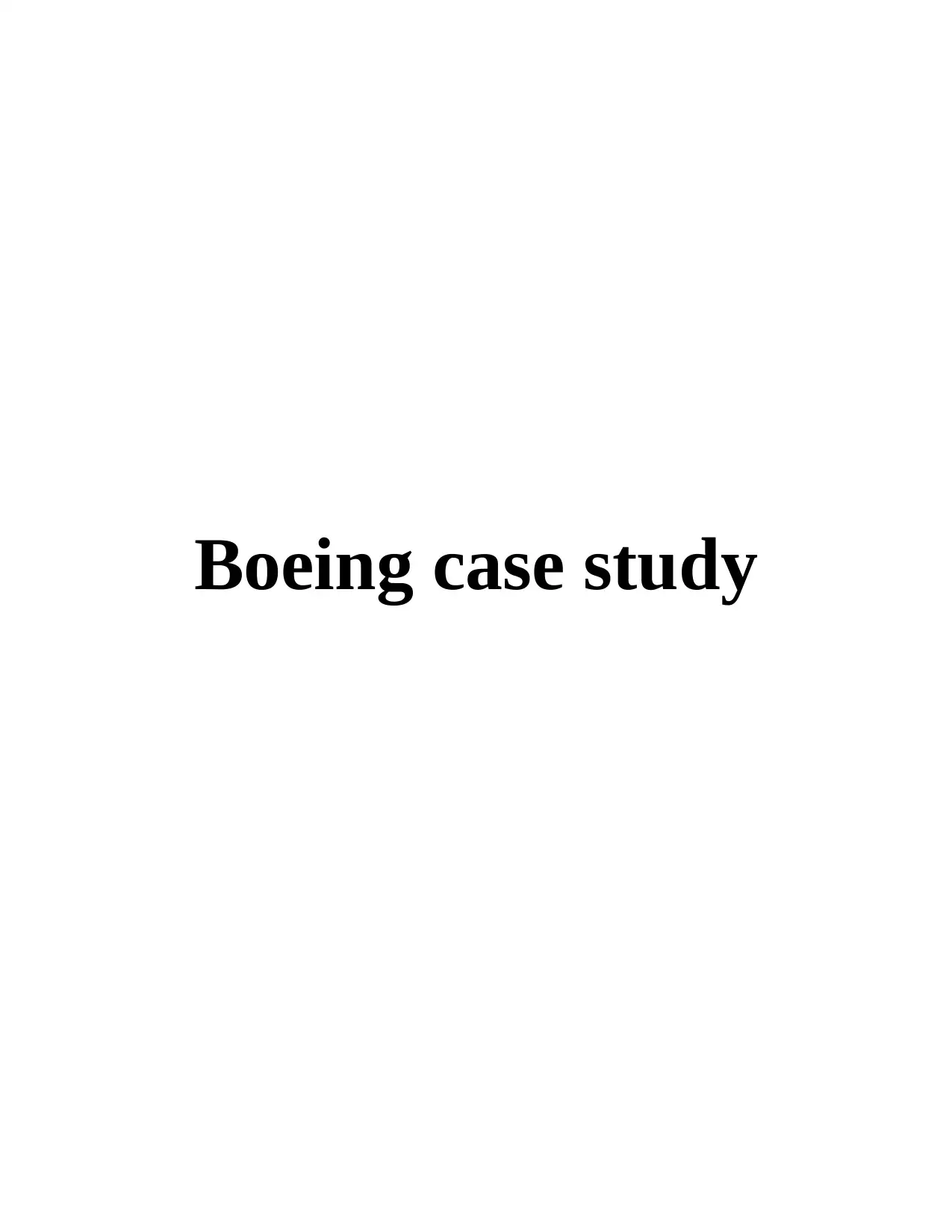
Boeing case study
Paraphrase This Document
Need a fresh take? Get an instant paraphrase of this document with our AI Paraphraser
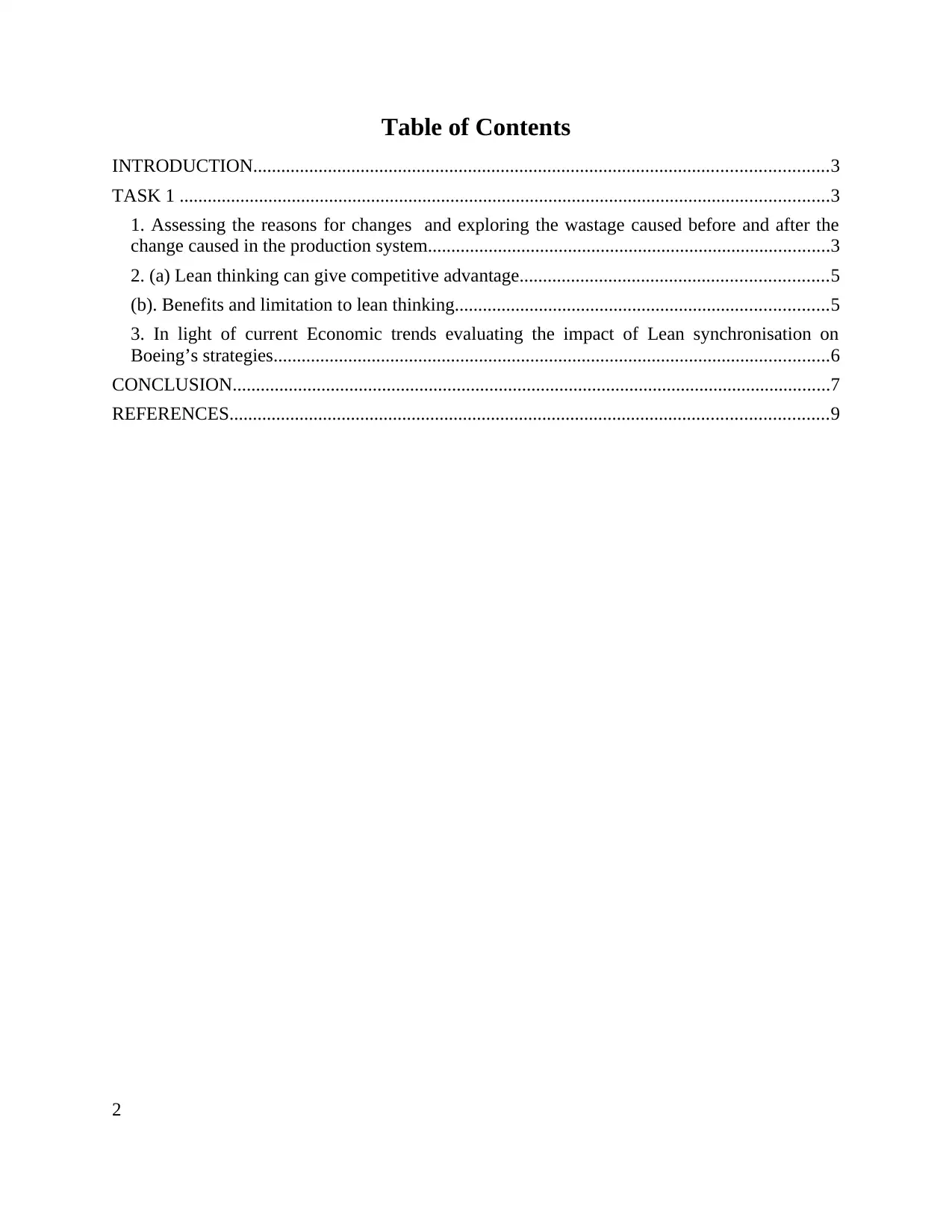
Table of Contents
INTRODUCTION...........................................................................................................................3
TASK 1 ...........................................................................................................................................3
1. Assessing the reasons for changes and exploring the wastage caused before and after the
change caused in the production system......................................................................................3
2. (a) Lean thinking can give competitive advantage..................................................................5
(b). Benefits and limitation to lean thinking................................................................................5
3. In light of current Economic trends evaluating the impact of Lean synchronisation on
Boeing’s strategies.......................................................................................................................6
CONCLUSION................................................................................................................................7
REFERENCES................................................................................................................................9
2
INTRODUCTION...........................................................................................................................3
TASK 1 ...........................................................................................................................................3
1. Assessing the reasons for changes and exploring the wastage caused before and after the
change caused in the production system......................................................................................3
2. (a) Lean thinking can give competitive advantage..................................................................5
(b). Benefits and limitation to lean thinking................................................................................5
3. In light of current Economic trends evaluating the impact of Lean synchronisation on
Boeing’s strategies.......................................................................................................................6
CONCLUSION................................................................................................................................7
REFERENCES................................................................................................................................9
2
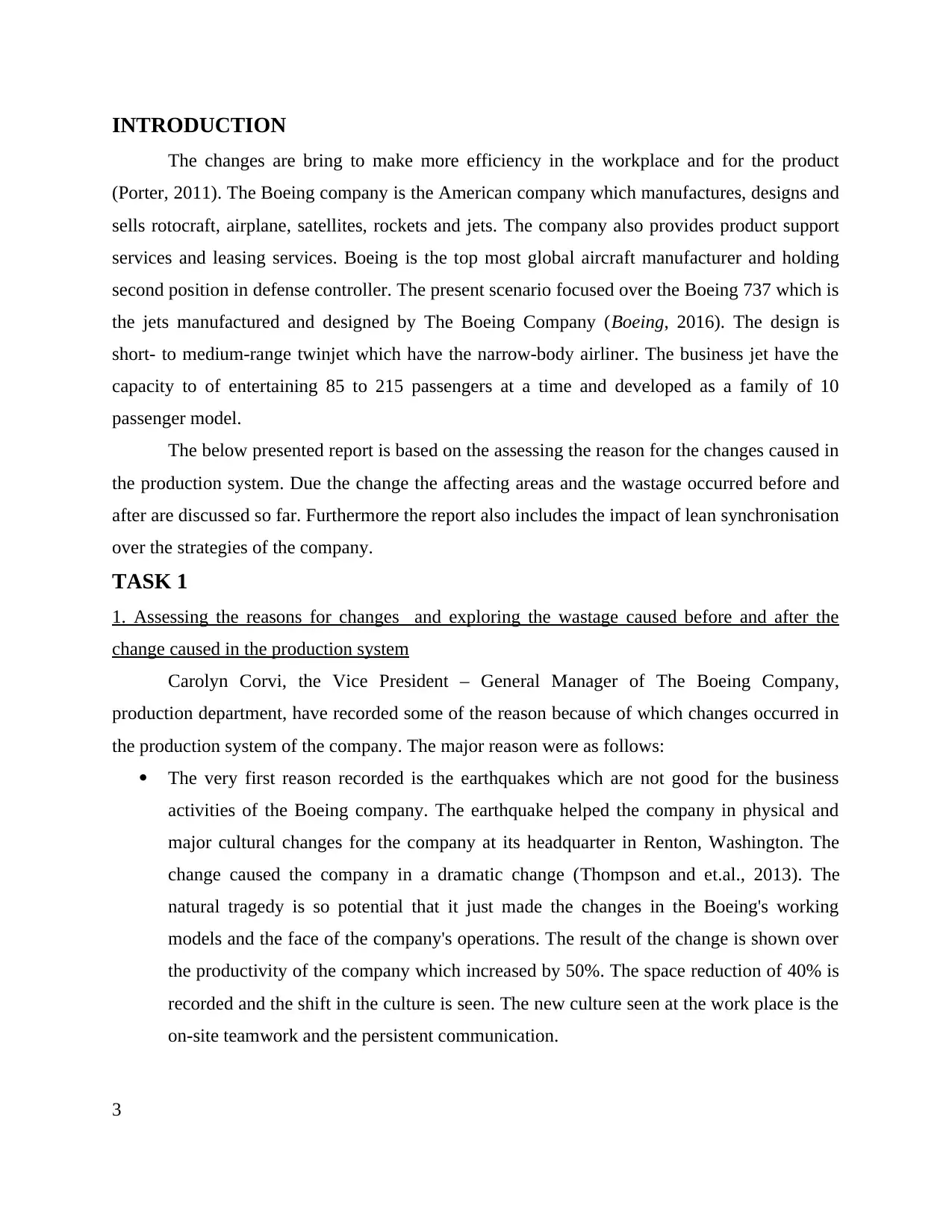
INTRODUCTION
The changes are bring to make more efficiency in the workplace and for the product
(Porter, 2011). The Boeing company is the American company which manufactures, designs and
sells rotocraft, airplane, satellites, rockets and jets. The company also provides product support
services and leasing services. Boeing is the top most global aircraft manufacturer and holding
second position in defense controller. The present scenario focused over the Boeing 737 which is
the jets manufactured and designed by The Boeing Company (Boeing, 2016). The design is
short- to medium-range twinjet which have the narrow-body airliner. The business jet have the
capacity to of entertaining 85 to 215 passengers at a time and developed as a family of 10
passenger model.
The below presented report is based on the assessing the reason for the changes caused in
the production system. Due the change the affecting areas and the wastage occurred before and
after are discussed so far. Furthermore the report also includes the impact of lean synchronisation
over the strategies of the company.
TASK 1
1. Assessing the reasons for changes and exploring the wastage caused before and after the
change caused in the production system
Carolyn Corvi, the Vice President – General Manager of The Boeing Company,
production department, have recorded some of the reason because of which changes occurred in
the production system of the company. The major reason were as follows:
The very first reason recorded is the earthquakes which are not good for the business
activities of the Boeing company. The earthquake helped the company in physical and
major cultural changes for the company at its headquarter in Renton, Washington. The
change caused the company in a dramatic change (Thompson and et.al., 2013). The
natural tragedy is so potential that it just made the changes in the Boeing's working
models and the face of the company's operations. The result of the change is shown over
the productivity of the company which increased by 50%. The space reduction of 40% is
recorded and the shift in the culture is seen. The new culture seen at the work place is the
on-site teamwork and the persistent communication.
3
The changes are bring to make more efficiency in the workplace and for the product
(Porter, 2011). The Boeing company is the American company which manufactures, designs and
sells rotocraft, airplane, satellites, rockets and jets. The company also provides product support
services and leasing services. Boeing is the top most global aircraft manufacturer and holding
second position in defense controller. The present scenario focused over the Boeing 737 which is
the jets manufactured and designed by The Boeing Company (Boeing, 2016). The design is
short- to medium-range twinjet which have the narrow-body airliner. The business jet have the
capacity to of entertaining 85 to 215 passengers at a time and developed as a family of 10
passenger model.
The below presented report is based on the assessing the reason for the changes caused in
the production system. Due the change the affecting areas and the wastage occurred before and
after are discussed so far. Furthermore the report also includes the impact of lean synchronisation
over the strategies of the company.
TASK 1
1. Assessing the reasons for changes and exploring the wastage caused before and after the
change caused in the production system
Carolyn Corvi, the Vice President – General Manager of The Boeing Company,
production department, have recorded some of the reason because of which changes occurred in
the production system of the company. The major reason were as follows:
The very first reason recorded is the earthquakes which are not good for the business
activities of the Boeing company. The earthquake helped the company in physical and
major cultural changes for the company at its headquarter in Renton, Washington. The
change caused the company in a dramatic change (Thompson and et.al., 2013). The
natural tragedy is so potential that it just made the changes in the Boeing's working
models and the face of the company's operations. The result of the change is shown over
the productivity of the company which increased by 50%. The space reduction of 40% is
recorded and the shift in the culture is seen. The new culture seen at the work place is the
on-site teamwork and the persistent communication.
3
⊘ This is a preview!⊘
Do you want full access?
Subscribe today to unlock all pages.

Trusted by 1+ million students worldwide
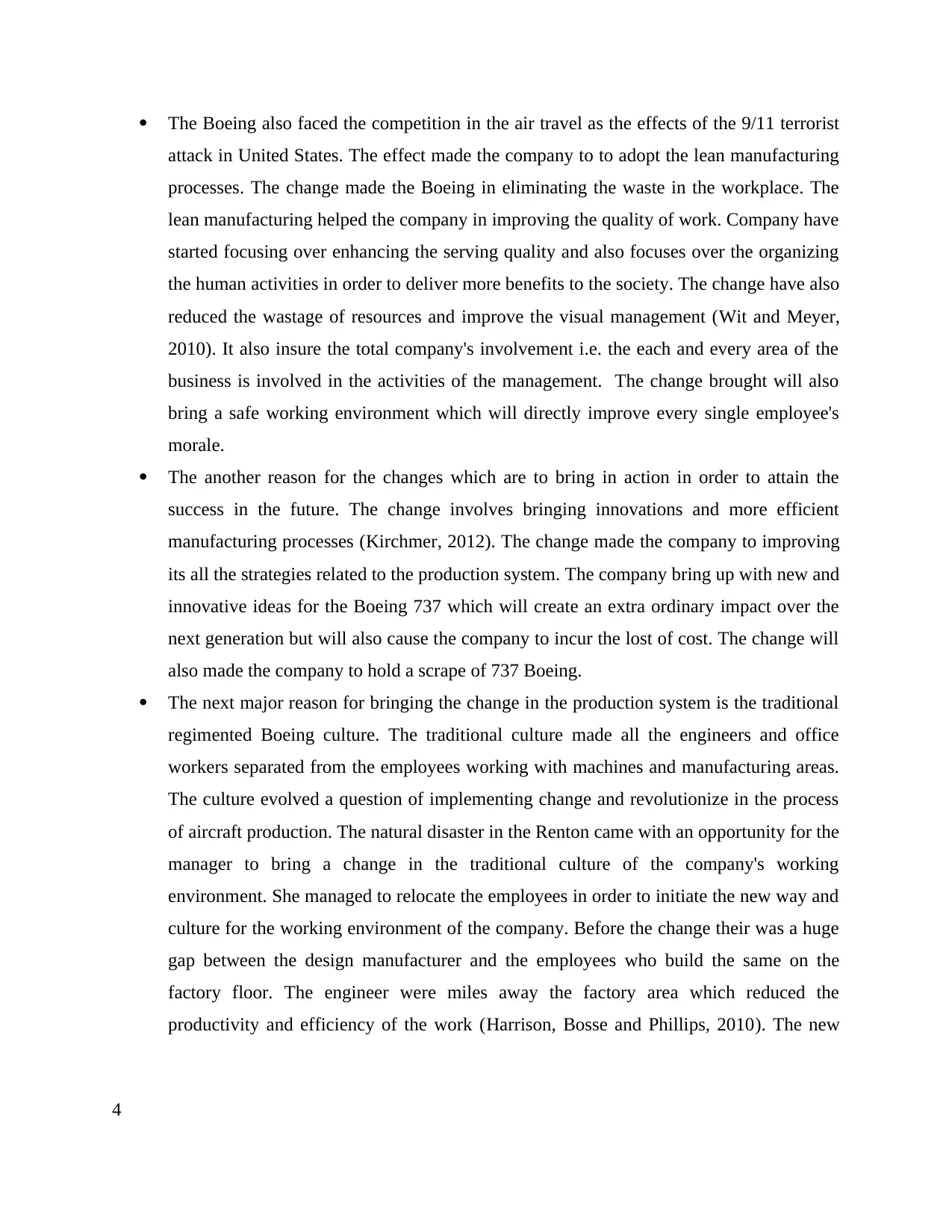
The Boeing also faced the competition in the air travel as the effects of the 9/11 terrorist
attack in United States. The effect made the company to to adopt the lean manufacturing
processes. The change made the Boeing in eliminating the waste in the workplace. The
lean manufacturing helped the company in improving the quality of work. Company have
started focusing over enhancing the serving quality and also focuses over the organizing
the human activities in order to deliver more benefits to the society. The change have also
reduced the wastage of resources and improve the visual management (Wit and Meyer,
2010). It also insure the total company's involvement i.e. the each and every area of the
business is involved in the activities of the management. The change brought will also
bring a safe working environment which will directly improve every single employee's
morale.
The another reason for the changes which are to bring in action in order to attain the
success in the future. The change involves bringing innovations and more efficient
manufacturing processes (Kirchmer, 2012). The change made the company to improving
its all the strategies related to the production system. The company bring up with new and
innovative ideas for the Boeing 737 which will create an extra ordinary impact over the
next generation but will also cause the company to incur the lost of cost. The change will
also made the company to hold a scrape of 737 Boeing.
The next major reason for bringing the change in the production system is the traditional
regimented Boeing culture. The traditional culture made all the engineers and office
workers separated from the employees working with machines and manufacturing areas.
The culture evolved a question of implementing change and revolutionize in the process
of aircraft production. The natural disaster in the Renton came with an opportunity for the
manager to bring a change in the traditional culture of the company's working
environment. She managed to relocate the employees in order to initiate the new way and
culture for the working environment of the company. Before the change their was a huge
gap between the design manufacturer and the employees who build the same on the
factory floor. The engineer were miles away the factory area which reduced the
productivity and efficiency of the work (Harrison, Bosse and Phillips, 2010). The new
4
attack in United States. The effect made the company to to adopt the lean manufacturing
processes. The change made the Boeing in eliminating the waste in the workplace. The
lean manufacturing helped the company in improving the quality of work. Company have
started focusing over enhancing the serving quality and also focuses over the organizing
the human activities in order to deliver more benefits to the society. The change have also
reduced the wastage of resources and improve the visual management (Wit and Meyer,
2010). It also insure the total company's involvement i.e. the each and every area of the
business is involved in the activities of the management. The change brought will also
bring a safe working environment which will directly improve every single employee's
morale.
The another reason for the changes which are to bring in action in order to attain the
success in the future. The change involves bringing innovations and more efficient
manufacturing processes (Kirchmer, 2012). The change made the company to improving
its all the strategies related to the production system. The company bring up with new and
innovative ideas for the Boeing 737 which will create an extra ordinary impact over the
next generation but will also cause the company to incur the lost of cost. The change will
also made the company to hold a scrape of 737 Boeing.
The next major reason for bringing the change in the production system is the traditional
regimented Boeing culture. The traditional culture made all the engineers and office
workers separated from the employees working with machines and manufacturing areas.
The culture evolved a question of implementing change and revolutionize in the process
of aircraft production. The natural disaster in the Renton came with an opportunity for the
manager to bring a change in the traditional culture of the company's working
environment. She managed to relocate the employees in order to initiate the new way and
culture for the working environment of the company. Before the change their was a huge
gap between the design manufacturer and the employees who build the same on the
factory floor. The engineer were miles away the factory area which reduced the
productivity and efficiency of the work (Harrison, Bosse and Phillips, 2010). The new
4
Paraphrase This Document
Need a fresh take? Get an instant paraphrase of this document with our AI Paraphraser
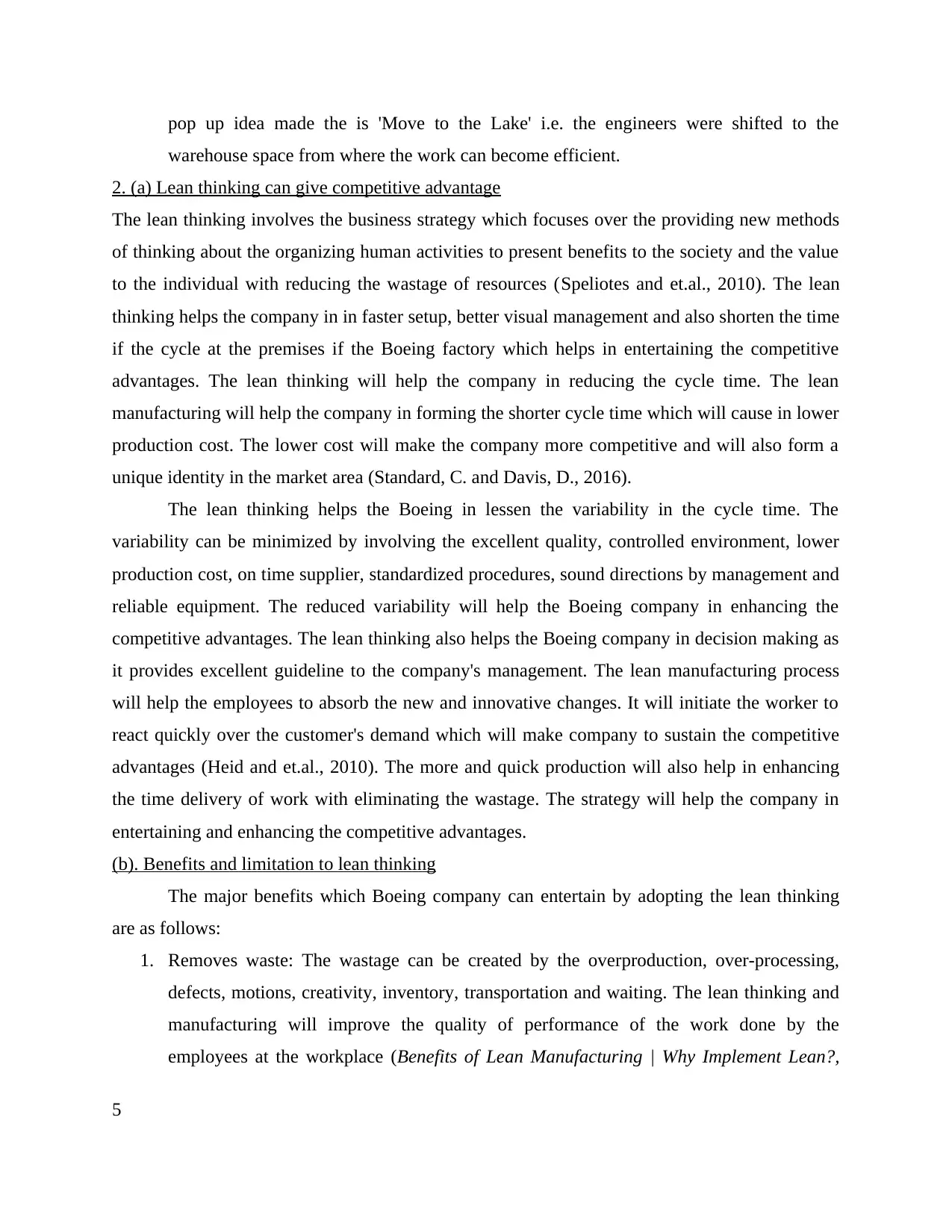
pop up idea made the is 'Move to the Lake' i.e. the engineers were shifted to the
warehouse space from where the work can become efficient.
2. (a) Lean thinking can give competitive advantage
The lean thinking involves the business strategy which focuses over the providing new methods
of thinking about the organizing human activities to present benefits to the society and the value
to the individual with reducing the wastage of resources (Speliotes and et.al., 2010). The lean
thinking helps the company in in faster setup, better visual management and also shorten the time
if the cycle at the premises if the Boeing factory which helps in entertaining the competitive
advantages. The lean thinking will help the company in reducing the cycle time. The lean
manufacturing will help the company in forming the shorter cycle time which will cause in lower
production cost. The lower cost will make the company more competitive and will also form a
unique identity in the market area (Standard, C. and Davis, D., 2016).
The lean thinking helps the Boeing in lessen the variability in the cycle time. The
variability can be minimized by involving the excellent quality, controlled environment, lower
production cost, on time supplier, standardized procedures, sound directions by management and
reliable equipment. The reduced variability will help the Boeing company in enhancing the
competitive advantages. The lean thinking also helps the Boeing company in decision making as
it provides excellent guideline to the company's management. The lean manufacturing process
will help the employees to absorb the new and innovative changes. It will initiate the worker to
react quickly over the customer's demand which will make company to sustain the competitive
advantages (Heid and et.al., 2010). The more and quick production will also help in enhancing
the time delivery of work with eliminating the wastage. The strategy will help the company in
entertaining and enhancing the competitive advantages.
(b). Benefits and limitation to lean thinking
The major benefits which Boeing company can entertain by adopting the lean thinking
are as follows:
1. Removes waste: The wastage can be created by the overproduction, over-processing,
defects, motions, creativity, inventory, transportation and waiting. The lean thinking and
manufacturing will improve the quality of performance of the work done by the
employees at the workplace (Benefits of Lean Manufacturing | Why Implement Lean?,
5
warehouse space from where the work can become efficient.
2. (a) Lean thinking can give competitive advantage
The lean thinking involves the business strategy which focuses over the providing new methods
of thinking about the organizing human activities to present benefits to the society and the value
to the individual with reducing the wastage of resources (Speliotes and et.al., 2010). The lean
thinking helps the company in in faster setup, better visual management and also shorten the time
if the cycle at the premises if the Boeing factory which helps in entertaining the competitive
advantages. The lean thinking will help the company in reducing the cycle time. The lean
manufacturing will help the company in forming the shorter cycle time which will cause in lower
production cost. The lower cost will make the company more competitive and will also form a
unique identity in the market area (Standard, C. and Davis, D., 2016).
The lean thinking helps the Boeing in lessen the variability in the cycle time. The
variability can be minimized by involving the excellent quality, controlled environment, lower
production cost, on time supplier, standardized procedures, sound directions by management and
reliable equipment. The reduced variability will help the Boeing company in enhancing the
competitive advantages. The lean thinking also helps the Boeing company in decision making as
it provides excellent guideline to the company's management. The lean manufacturing process
will help the employees to absorb the new and innovative changes. It will initiate the worker to
react quickly over the customer's demand which will make company to sustain the competitive
advantages (Heid and et.al., 2010). The more and quick production will also help in enhancing
the time delivery of work with eliminating the wastage. The strategy will help the company in
entertaining and enhancing the competitive advantages.
(b). Benefits and limitation to lean thinking
The major benefits which Boeing company can entertain by adopting the lean thinking
are as follows:
1. Removes waste: The wastage can be created by the overproduction, over-processing,
defects, motions, creativity, inventory, transportation and waiting. The lean thinking and
manufacturing will improve the quality of performance of the work done by the
employees at the workplace (Benefits of Lean Manufacturing | Why Implement Lean?,
5
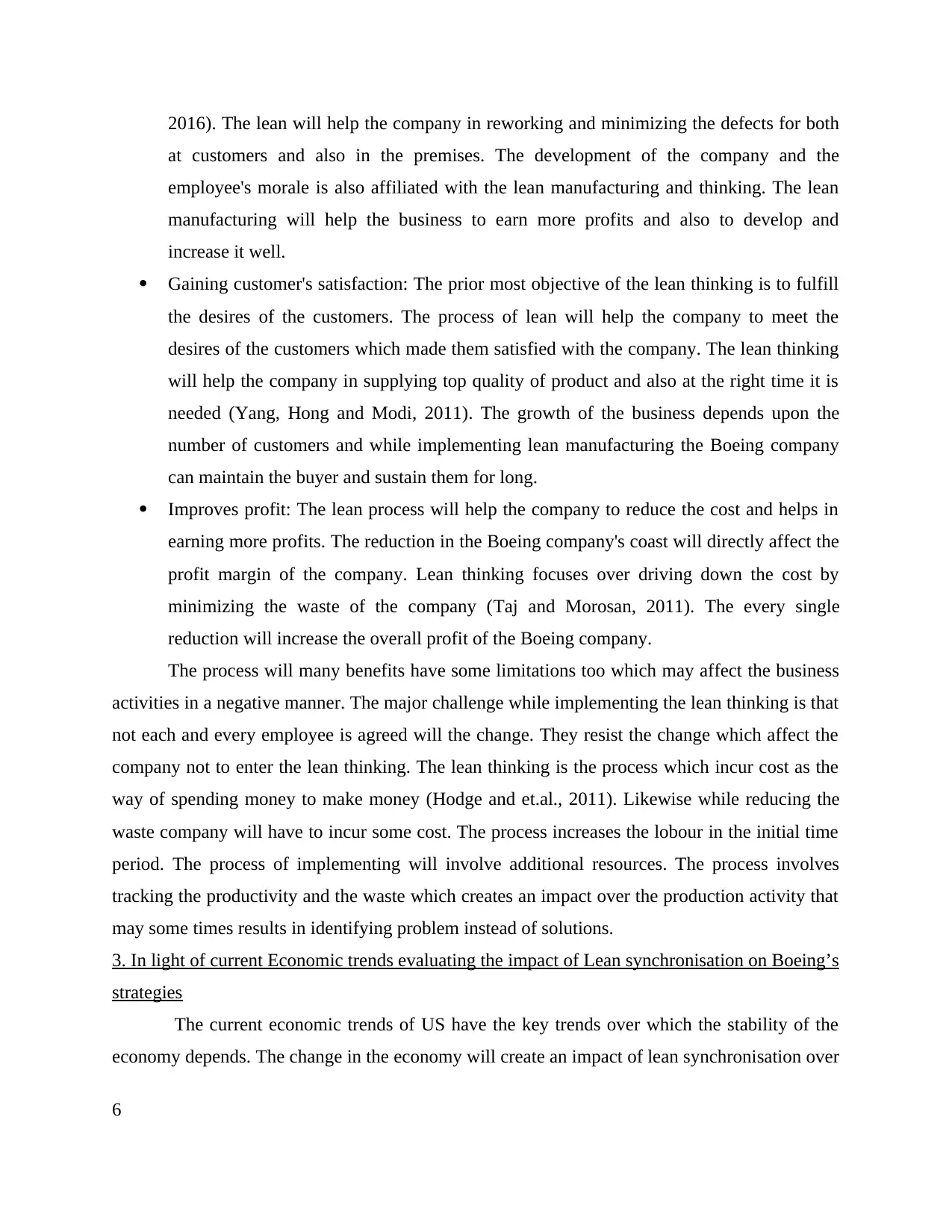
2016). The lean will help the company in reworking and minimizing the defects for both
at customers and also in the premises. The development of the company and the
employee's morale is also affiliated with the lean manufacturing and thinking. The lean
manufacturing will help the business to earn more profits and also to develop and
increase it well.
Gaining customer's satisfaction: The prior most objective of the lean thinking is to fulfill
the desires of the customers. The process of lean will help the company to meet the
desires of the customers which made them satisfied with the company. The lean thinking
will help the company in supplying top quality of product and also at the right time it is
needed (Yang, Hong and Modi, 2011). The growth of the business depends upon the
number of customers and while implementing lean manufacturing the Boeing company
can maintain the buyer and sustain them for long.
Improves profit: The lean process will help the company to reduce the cost and helps in
earning more profits. The reduction in the Boeing company's coast will directly affect the
profit margin of the company. Lean thinking focuses over driving down the cost by
minimizing the waste of the company (Taj and Morosan, 2011). The every single
reduction will increase the overall profit of the Boeing company.
The process will many benefits have some limitations too which may affect the business
activities in a negative manner. The major challenge while implementing the lean thinking is that
not each and every employee is agreed will the change. They resist the change which affect the
company not to enter the lean thinking. The lean thinking is the process which incur cost as the
way of spending money to make money (Hodge and et.al., 2011). Likewise while reducing the
waste company will have to incur some cost. The process increases the lobour in the initial time
period. The process of implementing will involve additional resources. The process involves
tracking the productivity and the waste which creates an impact over the production activity that
may some times results in identifying problem instead of solutions.
3. In light of current Economic trends evaluating the impact of Lean synchronisation on Boeing’s
strategies
The current economic trends of US have the key trends over which the stability of the
economy depends. The change in the economy will create an impact of lean synchronisation over
6
at customers and also in the premises. The development of the company and the
employee's morale is also affiliated with the lean manufacturing and thinking. The lean
manufacturing will help the business to earn more profits and also to develop and
increase it well.
Gaining customer's satisfaction: The prior most objective of the lean thinking is to fulfill
the desires of the customers. The process of lean will help the company to meet the
desires of the customers which made them satisfied with the company. The lean thinking
will help the company in supplying top quality of product and also at the right time it is
needed (Yang, Hong and Modi, 2011). The growth of the business depends upon the
number of customers and while implementing lean manufacturing the Boeing company
can maintain the buyer and sustain them for long.
Improves profit: The lean process will help the company to reduce the cost and helps in
earning more profits. The reduction in the Boeing company's coast will directly affect the
profit margin of the company. Lean thinking focuses over driving down the cost by
minimizing the waste of the company (Taj and Morosan, 2011). The every single
reduction will increase the overall profit of the Boeing company.
The process will many benefits have some limitations too which may affect the business
activities in a negative manner. The major challenge while implementing the lean thinking is that
not each and every employee is agreed will the change. They resist the change which affect the
company not to enter the lean thinking. The lean thinking is the process which incur cost as the
way of spending money to make money (Hodge and et.al., 2011). Likewise while reducing the
waste company will have to incur some cost. The process increases the lobour in the initial time
period. The process of implementing will involve additional resources. The process involves
tracking the productivity and the waste which creates an impact over the production activity that
may some times results in identifying problem instead of solutions.
3. In light of current Economic trends evaluating the impact of Lean synchronisation on Boeing’s
strategies
The current economic trends of US have the key trends over which the stability of the
economy depends. The change in the economy will create an impact of lean synchronisation over
6
⊘ This is a preview!⊘
Do you want full access?
Subscribe today to unlock all pages.

Trusted by 1+ million students worldwide
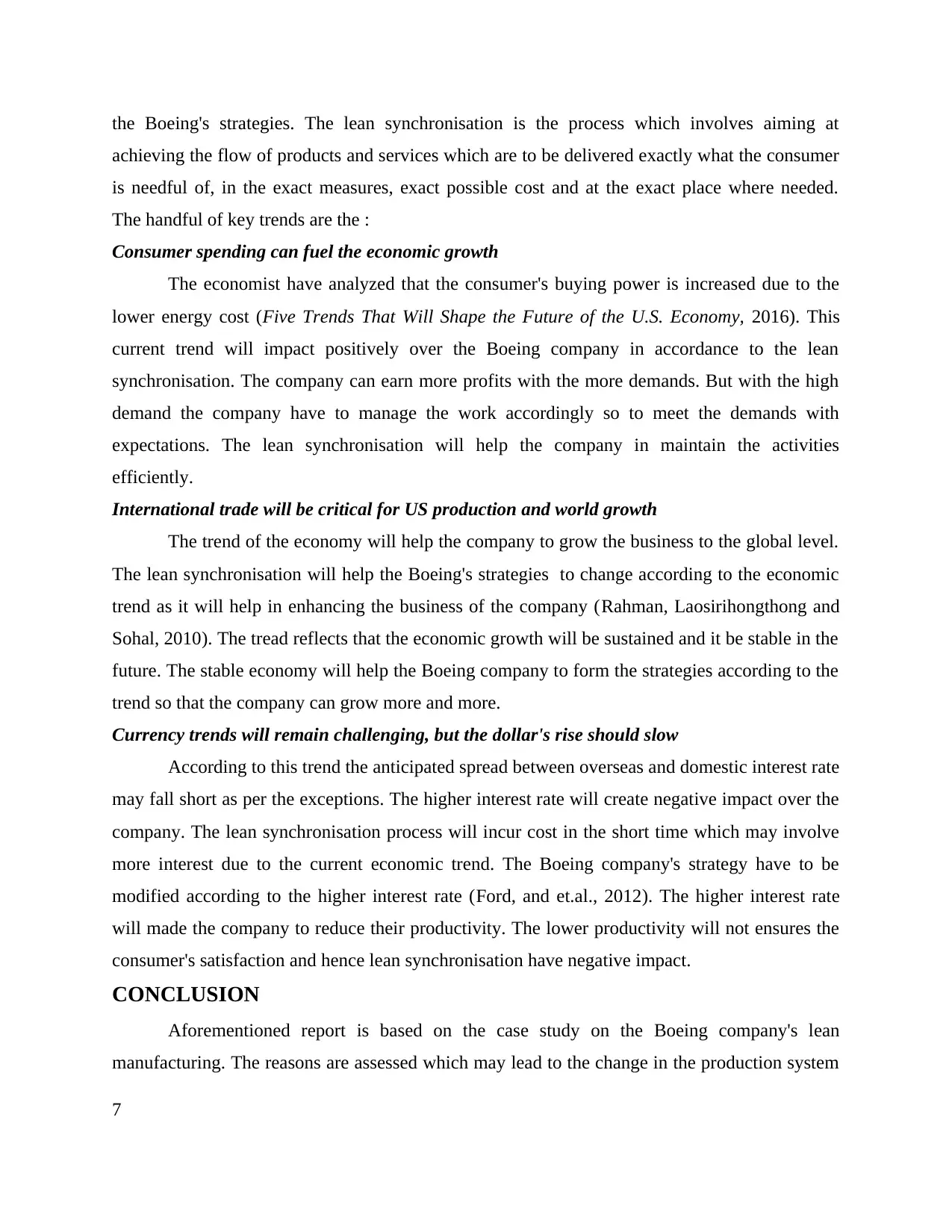
the Boeing's strategies. The lean synchronisation is the process which involves aiming at
achieving the flow of products and services which are to be delivered exactly what the consumer
is needful of, in the exact measures, exact possible cost and at the exact place where needed.
The handful of key trends are the :
Consumer spending can fuel the economic growth
The economist have analyzed that the consumer's buying power is increased due to the
lower energy cost (Five Trends That Will Shape the Future of the U.S. Economy, 2016). This
current trend will impact positively over the Boeing company in accordance to the lean
synchronisation. The company can earn more profits with the more demands. But with the high
demand the company have to manage the work accordingly so to meet the demands with
expectations. The lean synchronisation will help the company in maintain the activities
efficiently.
International trade will be critical for US production and world growth
The trend of the economy will help the company to grow the business to the global level.
The lean synchronisation will help the Boeing's strategies to change according to the economic
trend as it will help in enhancing the business of the company (Rahman, Laosirihongthong and
Sohal, 2010). The tread reflects that the economic growth will be sustained and it be stable in the
future. The stable economy will help the Boeing company to form the strategies according to the
trend so that the company can grow more and more.
Currency trends will remain challenging, but the dollar's rise should slow
According to this trend the anticipated spread between overseas and domestic interest rate
may fall short as per the exceptions. The higher interest rate will create negative impact over the
company. The lean synchronisation process will incur cost in the short time which may involve
more interest due to the current economic trend. The Boeing company's strategy have to be
modified according to the higher interest rate (Ford, and et.al., 2012). The higher interest rate
will made the company to reduce their productivity. The lower productivity will not ensures the
consumer's satisfaction and hence lean synchronisation have negative impact.
CONCLUSION
Aforementioned report is based on the case study on the Boeing company's lean
manufacturing. The reasons are assessed which may lead to the change in the production system
7
achieving the flow of products and services which are to be delivered exactly what the consumer
is needful of, in the exact measures, exact possible cost and at the exact place where needed.
The handful of key trends are the :
Consumer spending can fuel the economic growth
The economist have analyzed that the consumer's buying power is increased due to the
lower energy cost (Five Trends That Will Shape the Future of the U.S. Economy, 2016). This
current trend will impact positively over the Boeing company in accordance to the lean
synchronisation. The company can earn more profits with the more demands. But with the high
demand the company have to manage the work accordingly so to meet the demands with
expectations. The lean synchronisation will help the company in maintain the activities
efficiently.
International trade will be critical for US production and world growth
The trend of the economy will help the company to grow the business to the global level.
The lean synchronisation will help the Boeing's strategies to change according to the economic
trend as it will help in enhancing the business of the company (Rahman, Laosirihongthong and
Sohal, 2010). The tread reflects that the economic growth will be sustained and it be stable in the
future. The stable economy will help the Boeing company to form the strategies according to the
trend so that the company can grow more and more.
Currency trends will remain challenging, but the dollar's rise should slow
According to this trend the anticipated spread between overseas and domestic interest rate
may fall short as per the exceptions. The higher interest rate will create negative impact over the
company. The lean synchronisation process will incur cost in the short time which may involve
more interest due to the current economic trend. The Boeing company's strategy have to be
modified according to the higher interest rate (Ford, and et.al., 2012). The higher interest rate
will made the company to reduce their productivity. The lower productivity will not ensures the
consumer's satisfaction and hence lean synchronisation have negative impact.
CONCLUSION
Aforementioned report is based on the case study on the Boeing company's lean
manufacturing. The reasons are assessed which may lead to the change in the production system
7
Paraphrase This Document
Need a fresh take? Get an instant paraphrase of this document with our AI Paraphraser
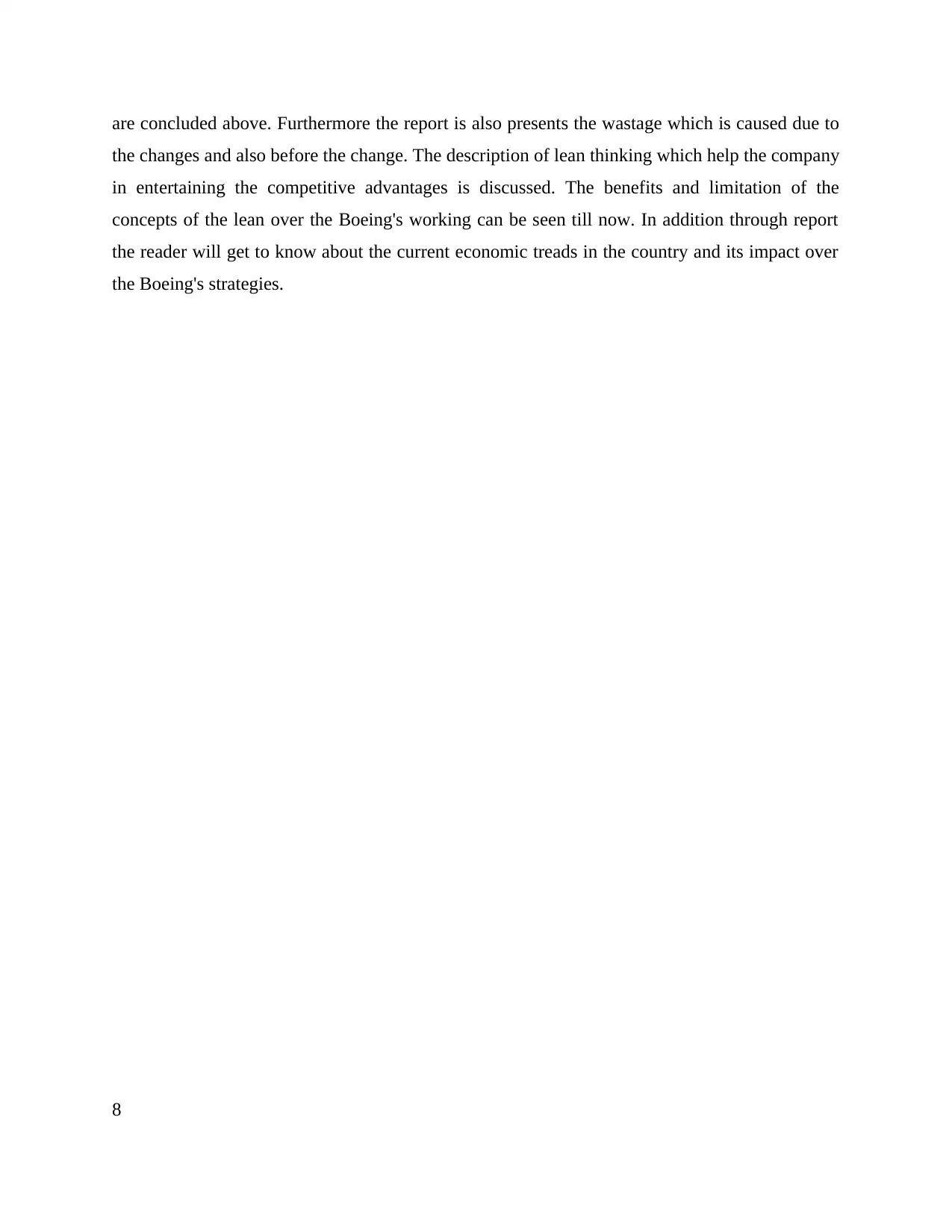
are concluded above. Furthermore the report is also presents the wastage which is caused due to
the changes and also before the change. The description of lean thinking which help the company
in entertaining the competitive advantages is discussed. The benefits and limitation of the
concepts of the lean over the Boeing's working can be seen till now. In addition through report
the reader will get to know about the current economic treads in the country and its impact over
the Boeing's strategies.
8
the changes and also before the change. The description of lean thinking which help the company
in entertaining the competitive advantages is discussed. The benefits and limitation of the
concepts of the lean over the Boeing's working can be seen till now. In addition through report
the reader will get to know about the current economic treads in the country and its impact over
the Boeing's strategies.
8
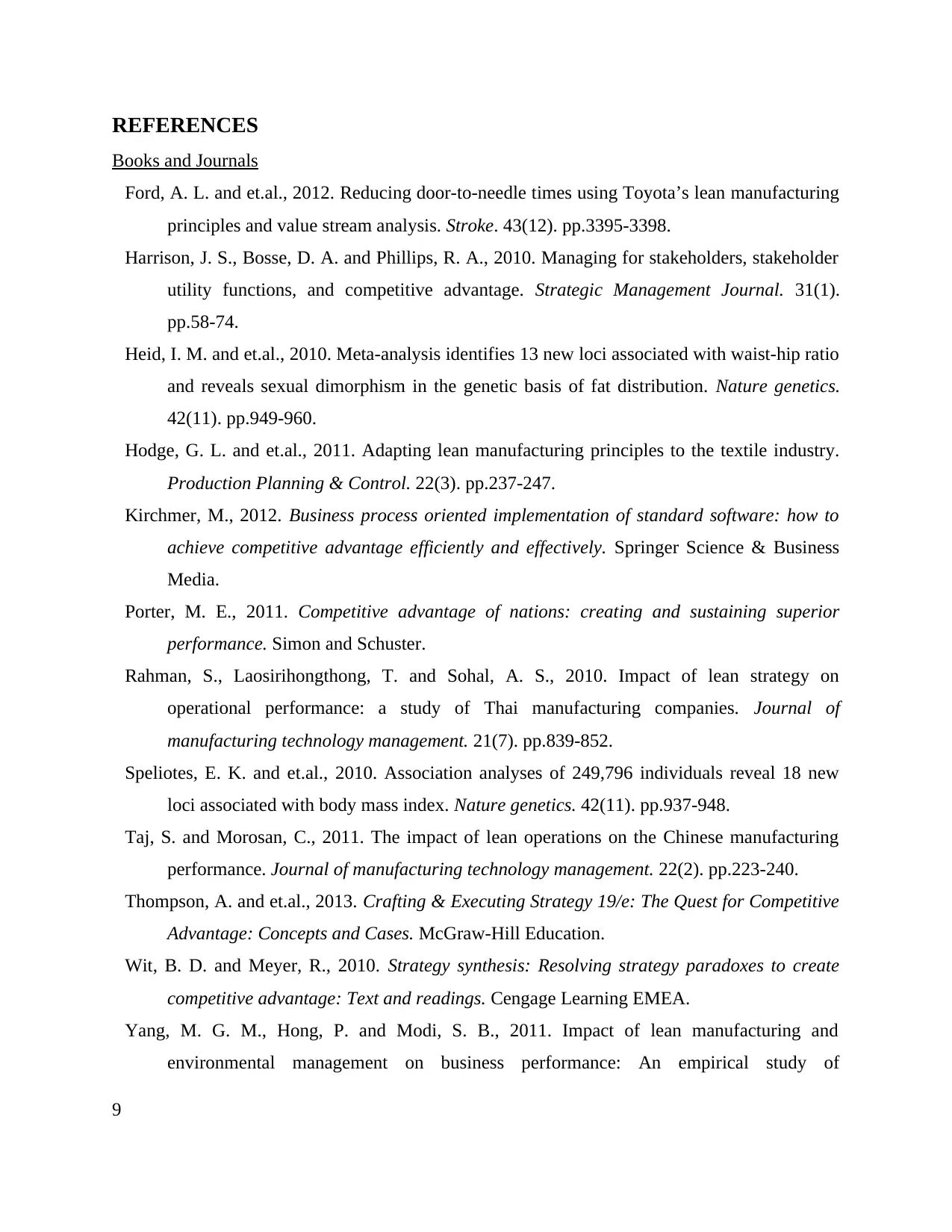
REFERENCES
Books and Journals
Ford, A. L. and et.al., 2012. Reducing door-to-needle times using Toyota’s lean manufacturing
principles and value stream analysis. Stroke. 43(12). pp.3395-3398.
Harrison, J. S., Bosse, D. A. and Phillips, R. A., 2010. Managing for stakeholders, stakeholder
utility functions, and competitive advantage. Strategic Management Journal. 31(1).
pp.58-74.
Heid, I. M. and et.al., 2010. Meta-analysis identifies 13 new loci associated with waist-hip ratio
and reveals sexual dimorphism in the genetic basis of fat distribution. Nature genetics.
42(11). pp.949-960.
Hodge, G. L. and et.al., 2011. Adapting lean manufacturing principles to the textile industry.
Production Planning & Control. 22(3). pp.237-247.
Kirchmer, M., 2012. Business process oriented implementation of standard software: how to
achieve competitive advantage efficiently and effectively. Springer Science & Business
Media.
Porter, M. E., 2011. Competitive advantage of nations: creating and sustaining superior
performance. Simon and Schuster.
Rahman, S., Laosirihongthong, T. and Sohal, A. S., 2010. Impact of lean strategy on
operational performance: a study of Thai manufacturing companies. Journal of
manufacturing technology management. 21(7). pp.839-852.
Speliotes, E. K. and et.al., 2010. Association analyses of 249,796 individuals reveal 18 new
loci associated with body mass index. Nature genetics. 42(11). pp.937-948.
Taj, S. and Morosan, C., 2011. The impact of lean operations on the Chinese manufacturing
performance. Journal of manufacturing technology management. 22(2). pp.223-240.
Thompson, A. and et.al., 2013. Crafting & Executing Strategy 19/e: The Quest for Competitive
Advantage: Concepts and Cases. McGraw-Hill Education.
Wit, B. D. and Meyer, R., 2010. Strategy synthesis: Resolving strategy paradoxes to create
competitive advantage: Text and readings. Cengage Learning EMEA.
Yang, M. G. M., Hong, P. and Modi, S. B., 2011. Impact of lean manufacturing and
environmental management on business performance: An empirical study of
9
Books and Journals
Ford, A. L. and et.al., 2012. Reducing door-to-needle times using Toyota’s lean manufacturing
principles and value stream analysis. Stroke. 43(12). pp.3395-3398.
Harrison, J. S., Bosse, D. A. and Phillips, R. A., 2010. Managing for stakeholders, stakeholder
utility functions, and competitive advantage. Strategic Management Journal. 31(1).
pp.58-74.
Heid, I. M. and et.al., 2010. Meta-analysis identifies 13 new loci associated with waist-hip ratio
and reveals sexual dimorphism in the genetic basis of fat distribution. Nature genetics.
42(11). pp.949-960.
Hodge, G. L. and et.al., 2011. Adapting lean manufacturing principles to the textile industry.
Production Planning & Control. 22(3). pp.237-247.
Kirchmer, M., 2012. Business process oriented implementation of standard software: how to
achieve competitive advantage efficiently and effectively. Springer Science & Business
Media.
Porter, M. E., 2011. Competitive advantage of nations: creating and sustaining superior
performance. Simon and Schuster.
Rahman, S., Laosirihongthong, T. and Sohal, A. S., 2010. Impact of lean strategy on
operational performance: a study of Thai manufacturing companies. Journal of
manufacturing technology management. 21(7). pp.839-852.
Speliotes, E. K. and et.al., 2010. Association analyses of 249,796 individuals reveal 18 new
loci associated with body mass index. Nature genetics. 42(11). pp.937-948.
Taj, S. and Morosan, C., 2011. The impact of lean operations on the Chinese manufacturing
performance. Journal of manufacturing technology management. 22(2). pp.223-240.
Thompson, A. and et.al., 2013. Crafting & Executing Strategy 19/e: The Quest for Competitive
Advantage: Concepts and Cases. McGraw-Hill Education.
Wit, B. D. and Meyer, R., 2010. Strategy synthesis: Resolving strategy paradoxes to create
competitive advantage: Text and readings. Cengage Learning EMEA.
Yang, M. G. M., Hong, P. and Modi, S. B., 2011. Impact of lean manufacturing and
environmental management on business performance: An empirical study of
9
⊘ This is a preview!⊘
Do you want full access?
Subscribe today to unlock all pages.

Trusted by 1+ million students worldwide
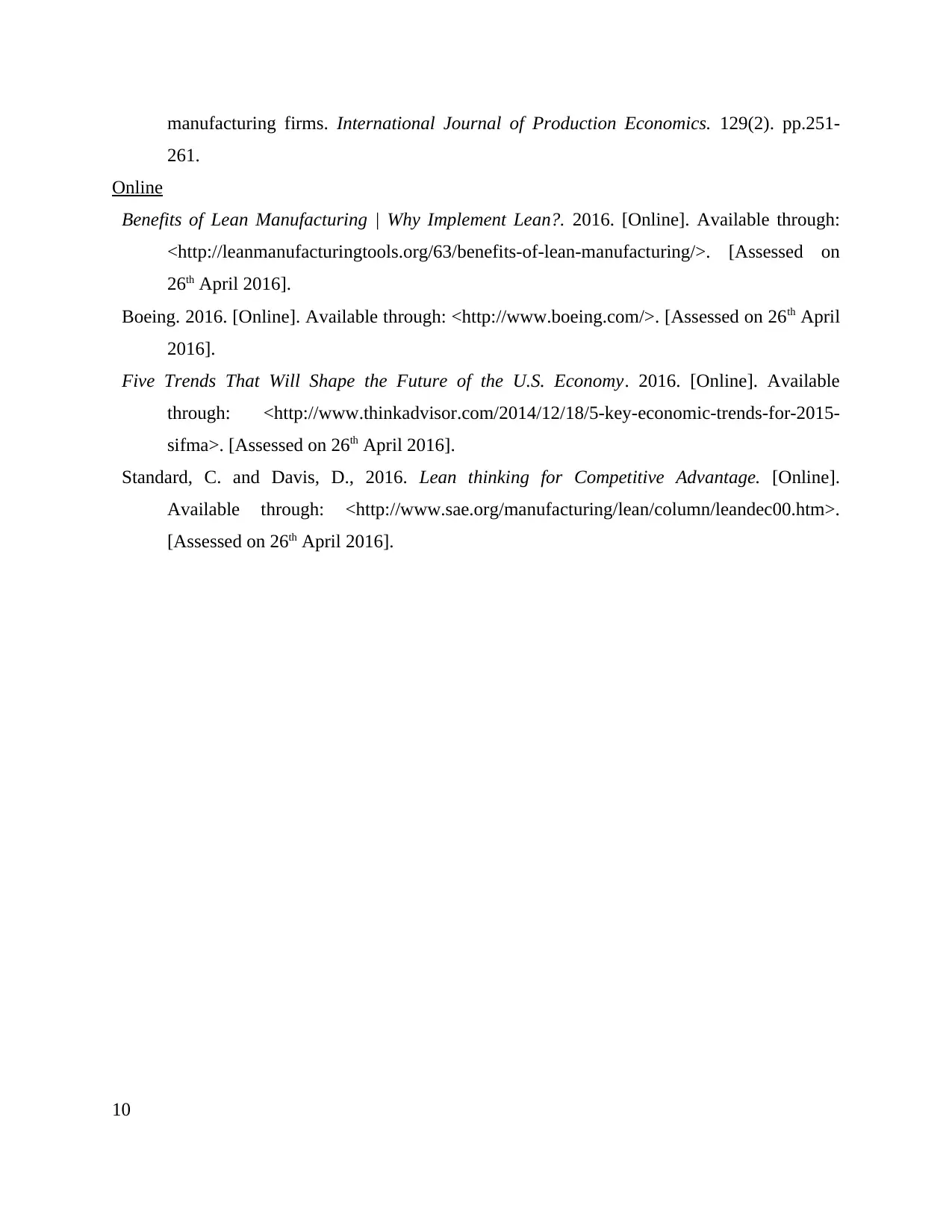
manufacturing firms. International Journal of Production Economics. 129(2). pp.251-
261.
Online
Benefits of Lean Manufacturing | Why Implement Lean?. 2016. [Online]. Available through:
<http://leanmanufacturingtools.org/63/benefits-of-lean-manufacturing/>. [Assessed on
26th April 2016].
Boeing. 2016. [Online]. Available through: <http://www.boeing.com/>. [Assessed on 26th April
2016].
Five Trends That Will Shape the Future of the U.S. Economy. 2016. [Online]. Available
through: <http://www.thinkadvisor.com/2014/12/18/5-key-economic-trends-for-2015-
sifma>. [Assessed on 26th April 2016].
Standard, C. and Davis, D., 2016. Lean thinking for Competitive Advantage. [Online].
Available through: <http://www.sae.org/manufacturing/lean/column/leandec00.htm>.
[Assessed on 26th April 2016].
10
261.
Online
Benefits of Lean Manufacturing | Why Implement Lean?. 2016. [Online]. Available through:
<http://leanmanufacturingtools.org/63/benefits-of-lean-manufacturing/>. [Assessed on
26th April 2016].
Boeing. 2016. [Online]. Available through: <http://www.boeing.com/>. [Assessed on 26th April
2016].
Five Trends That Will Shape the Future of the U.S. Economy. 2016. [Online]. Available
through: <http://www.thinkadvisor.com/2014/12/18/5-key-economic-trends-for-2015-
sifma>. [Assessed on 26th April 2016].
Standard, C. and Davis, D., 2016. Lean thinking for Competitive Advantage. [Online].
Available through: <http://www.sae.org/manufacturing/lean/column/leandec00.htm>.
[Assessed on 26th April 2016].
10
1 out of 10
Related Documents
Your All-in-One AI-Powered Toolkit for Academic Success.
+13062052269
info@desklib.com
Available 24*7 on WhatsApp / Email
![[object Object]](/_next/static/media/star-bottom.7253800d.svg)
Unlock your academic potential
Copyright © 2020–2025 A2Z Services. All Rights Reserved. Developed and managed by ZUCOL.





